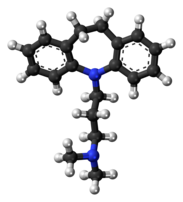
Back إيميبرامين Arabic ایمیپرامین AZB Имипрамин Bulgarian Imipramin Welsh Imipramin German Imipramina Spanish Imipramiin Estonian ایمیپرامین Persian Imipramiini Finnish Imipramine French
 | |
 | |
| Clinical data | |
|---|---|
| Trade names | Tofranil, Tofranil-PM, others |
| Other names | Melipramine; G-22355 |
| AHFS/Drugs.com | Monograph |
| MedlinePlus | a682389 |
| License data |
|
| Pregnancy category |
|
| Routes of administration | By mouth, intramuscular injection |
| ATC code | |
| Legal status | |
| Legal status | |
| Pharmacokinetic data | |
| Bioavailability | 94–96%[3] |
| Protein binding | 86%[4] |
| Metabolism | Liver (CYP1A2, CYP2C19, CYP2D6)[4] |
| Metabolites | Desipramine[4] |
| Elimination half-life | 20 hours[4] |
| Excretion | Kidney (80%), fecal (20%)[4] |
| Identifiers | |
| |
| CAS Number | |
| PubChem CID | |
| IUPHAR/BPS | |
| DrugBank | |
| ChemSpider | |
| UNII | |
| KEGG | |
| ChEBI | |
| ChEMBL | |
| PDB ligand | |
| CompTox Dashboard (EPA) | |
| ECHA InfoCard | 100.000.039 |
| Chemical and physical data | |
| Formula | C19H24N2 |
| Molar mass | 280.415 g·mol−1 |
| 3D model (JSmol) | |
| |
| |
| (verify) | |
Imipramine, sold under the brand name Tofranil, among others, is a tricyclic antidepressant (TCA) mainly used in the treatment of depression. It is also effective in treating anxiety and panic disorder. Imipramine is taken by mouth.
Common side effects of imipramine include dry mouth, drowsiness, dizziness, low blood pressure, rapid heart rate, urinary retention, and electrocardiogram changes. Overdose of the medication can result in death. Imipramine appears to work by increasing levels of serotonin and norepinephrine and by blocking certain serotonin, adrenergic, histamine, and cholinergic receptors.
Imipramine was discovered in 1951 and was introduced for medical use in 1957. It was the first TCA to be marketed. Imipramine and TCAs other than amitriptyline (which, at least in the U.K., is prescribed comparatively as frequently as SSRIs) have decreased in prescription frequency with the rise of SSRIs—which have fewer inherent side effects and are far safer in overdose.[citation needed] Regardless of its caveats, imipramine retains importance in psychopharmacology and pediatrics (e.g., with childhood enuresis).[5][6]
- ^ "Imipramine Use During Pregnancy". Drugs.com. 28 August 2019. Retrieved 7 February 2020.
- ^ Anvisa (2023-03-31). "RDC Nº 784 - Listas de Substâncias Entorpecentes, Psicotrópicas, Precursoras e Outras sob Controle Especial" [Collegiate Board Resolution No. 784 - Lists of Narcotic, Psychotropic, Precursor, and Other Substances under Special Control] (in Brazilian Portuguese). Diário Oficial da União (published 2023-04-04). Archived from the original on 2023-08-03. Retrieved 2023-08-16.
- ^ Heck HA, Buttrill SE, Flynn NW, Dyer RL, Anbar M, Cairns T, et al. (June 1979). "Bioavailability of imipramine tablets relative to a stable isotope-labeled internal standard: increasing the power of bioavailability tests". Journal of Pharmacokinetics and Biopharmaceutics. 7 (3): 233–248. doi:10.1007/BF01060015. PMID 480146. S2CID 23232584.
- ^ a b c d e "Product Information Tolerade (imipramine hydrochloride)". TGA eBusiness Services. PMIP Pty Ltd. 4 June 2013. Archived from the original on 10 December 2019. Retrieved 16 October 2013.
- ^ Michelson LK, Marchione K (February 1991). "Behavioral, cognitive, and pharmacological treatments of panic disorder with agoraphobia: critique and synthesis". Journal of Consulting and Clinical Psychology. 59 (1): 100–14. doi:10.1037/0022-006x.59.1.100. PMID 2002125.
- ^ Schwartz TL, Nihalani N, Simionescu M, Hopkins G (2005). "History repeats itself: pharmacodynamic trends in the treatment of anxiety disorders". Current Pharmaceutical Design. 11 (2): 255–63. doi:10.2174/1381612053382214. PMID 15638761.